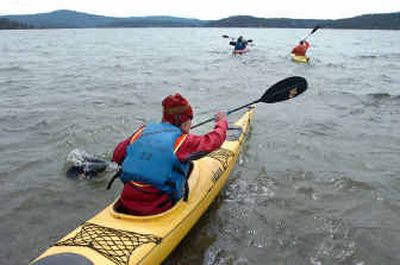MIND BODY

Sweat, skill and surprise are three key elements facing participants in the region’s first outdoor adventure race.
The NIChallenge is scheduled for May 7 at Farragut State Park, sponsored by the North Idaho College Student Activities Department.
The multi-sport event is open to students and non-students who can form two-person or four-person teams to work together on a land-and-water course that should take three to six hours to cover.
“This is a one-day sprint-course version of the adventure races people see on TV that sometimes go four or five days,” said Paul Chivvis, coordinator of NIC’s Outdoor Pursuits.
The course, which is still being worked out, will include 10 to 15 miles of mountain biking, 4 to 6 miles of trail running and 2 to 5 miles of paddling plus a manmade obstacle, problem solving and surprises.
“The course isn’t necessarily a precise path,” explained Jon Totten, Outdoor Pursuits assistant coordinator. “You have to use a map and use your head.
“You can cut corners as long as you hit all of the checkpoints. But you’ll have to weigh the advantages and disadvantages of bushwhacking.”
Team members must stay within 100 feet of each other at all times. “You have to work together,” he said.
“The start is anti-climactic because when the starter says “Go!” they don’t go anywhere. Each team first must open a bag and look and the map and directions. Until then, they have little idea of where they’re going.”
Race organizers gave a few hints about the course that could help team in choosing their members.
“The running one long distance all at once,” he said. “It’s broken up into stages between other things. So a strong mountain biking or paddling team might have an advantage over a team that strong only in running.”
“The biking section will have a good hill at the start and lots of smaller ones in between,” Chivvis said.
With the exception of sea kayaks, which can be rented, participants must provide all of their own bikes, gear and supplies.
“There won’t be any aid stations to get food or water,” Totten said. “Smart teams will carry some and stash the rest at transition points before the race.”
The $75 per person entry fee is about par for the course of adventure racing, Chivvis said, noting that event insurance costs $1,500, the Farragut fee is $500, advertising is at least $500, consulting fees $600, other bills are not in, and each entrant gets a shirt, catered meal and snacks.
“We expect to run in the red, but any proceeds would go back into the race for next year,” he said.
Six NIC students formed three two-person teams for a trial run on an abbreviated 10-minute version of the event recently.
The demonstration gave race organizers a few ideas for modifications and clearly showed potential race participants that a little practice is advisable in addition to overall conditioning.
“We run the outdoor program so were in pretty decent shape,” said Chivvis, noting that a four-person team from the Outdoor Pursuits department entered an adventure race in Leavenworth last year and won first place in their category.
But a member of that team, Emily Compton, Associated Students of NIC vice president, couldn’t follower her teammate Rachel Molsee over a manmade wall obstacle that was tested at the demonstration.
“Emily’s pretty tough,” said a smiling and somewhat masochistic-looking Totten, the obstacle designer. “We’ll probably increase the angle of the wall to make it easier to climb.”
He also noted that he’s planning to spice up the hunt for checkpoints by putting some on rocks that must be climbed or hanging from trees in a manner that could be missed if a team is concentrating on the ground to avoid tripping.
“And we have a special thing we stole from “Survivor” to make the racers think near the end, when they’re tired and thinking isn’t easy,” he added.
The demonstration also indicated that teams should practice running onto a beach and launching two-seater kayaks.
Knowing how to coordinate paddling and steer a kayak could save some time, too, it appeared.
“It’s common for a lot of racers to be good runners or bikers while being weak on one of the other things, like kayaking,” Totten said. “That’s the beauty of this race. To be good at all three takes some effort.”
The race will be added to the Challenge Adventure Race Series, which includes events at Lake Wenatchee and Bellingham, Chivvis said.